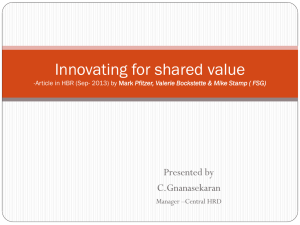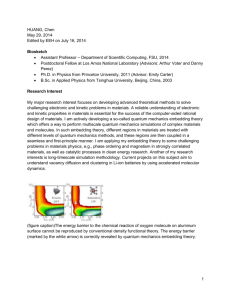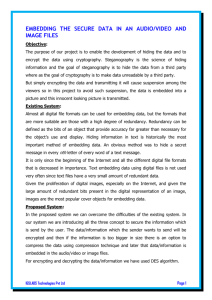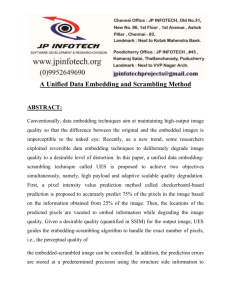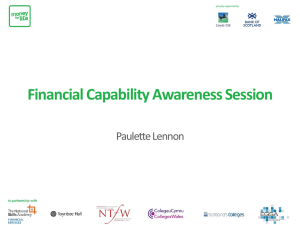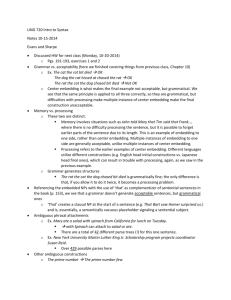Cepstral Domain Modification of Audio Signals for Data Embedding
advertisement
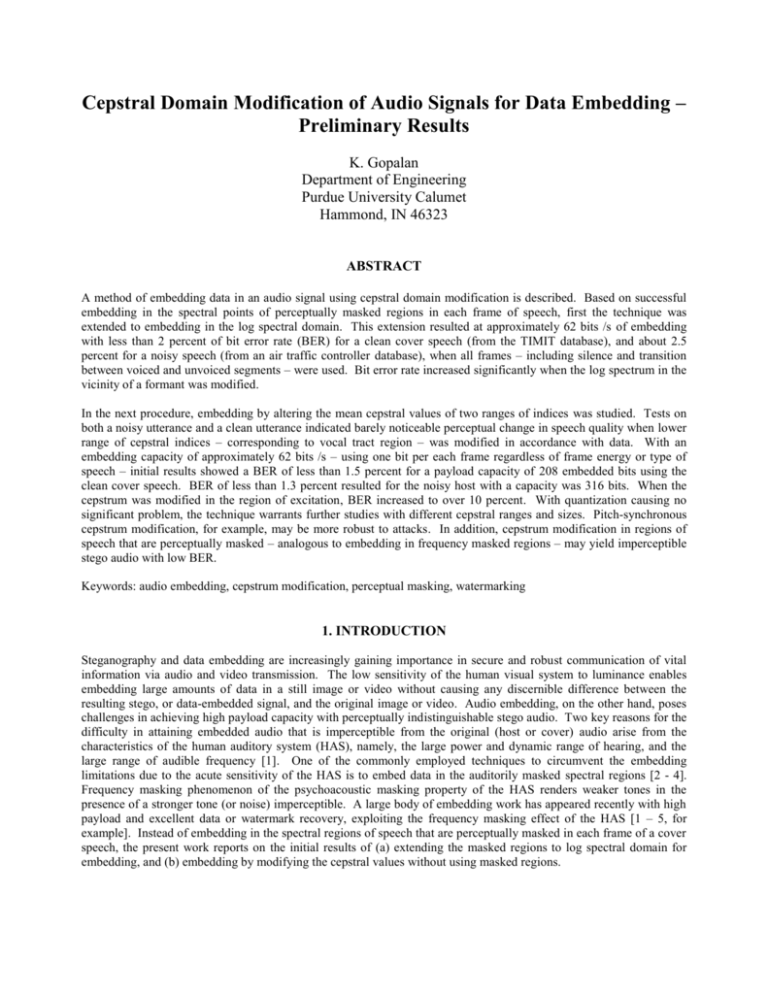
Cepstral Domain Modification of Audio Signals for Data Embedding – Preliminary Results K. Gopalan Department of Engineering Purdue University Calumet Hammond, IN 46323 ABSTRACT A method of embedding data in an audio signal using cepstral domain modification is described. Based on successful embedding in the spectral points of perceptually masked regions in each frame of speech, first the technique was extended to embedding in the log spectral domain. This extension resulted at approximately 62 bits /s of embedding with less than 2 percent of bit error rate (BER) for a clean cover speech (from the TIMIT database), and about 2.5 percent for a noisy speech (from an air traffic controller database), when all frames – including silence and transition between voiced and unvoiced segments – were used. Bit error rate increased significantly when the log spectrum in the vicinity of a formant was modified. In the next procedure, embedding by altering the mean cepstral values of two ranges of indices was studied. Tests on both a noisy utterance and a clean utterance indicated barely noticeable perceptual change in speech quality when lower range of cepstral indices – corresponding to vocal tract region – was modified in accordance with data. With an embedding capacity of approximately 62 bits /s – using one bit per each frame regardless of frame energy or type of speech – initial results showed a BER of less than 1.5 percent for a payload capacity of 208 embedded bits using the clean cover speech. BER of less than 1.3 percent resulted for the noisy host with a capacity was 316 bits. When the cepstrum was modified in the region of excitation, BER increased to over 10 percent. With quantization causing no significant problem, the technique warrants further studies with different cepstral ranges and sizes. Pitch-synchronous cepstrum modification, for example, may be more robust to attacks. In addition, cepstrum modification in regions of speech that are perceptually masked – analogous to embedding in frequency masked regions – may yield imperceptible stego audio with low BER. Keywords: audio embedding, cepstrum modification, perceptual masking, watermarking 1. INTRODUCTION Steganography and data embedding are increasingly gaining importance in secure and robust communication of vital information via audio and video transmission. The low sensitivity of the human visual system to luminance enables embedding large amounts of data in a still image or video without causing any discernible difference between the resulting stego, or data-embedded signal, and the original image or video. Audio embedding, on the other hand, poses challenges in achieving high payload capacity with perceptually indistinguishable stego audio. Two key reasons for the difficulty in attaining embedded audio that is imperceptible from the original (host or cover) audio arise from the characteristics of the human auditory system (HAS), namely, the large power and dynamic range of hearing, and the large range of audible frequency [1]. One of the commonly employed techniques to circumvent the embedding limitations due to the acute sensitivity of the HAS is to embed data in the auditorily masked spectral regions [2 - 4]. Frequency masking phenomenon of the psychoacoustic masking property of the HAS renders weaker tones in the presence of a stronger tone (or noise) imperceptible. A large body of embedding work has appeared recently with high payload and excellent data or watermark recovery, exploiting the frequency masking effect of the HAS [1 – 5, for example]. Instead of embedding in the spectral regions of speech that are perceptually masked in each frame of a cover speech, the present work reports on the initial results of (a) extending the masked regions to log spectral domain for embedding, and (b) embedding by modifying the cepstral values without using masked regions. 2. CEPSTRAL DOMAIN SPEECH PROCESSING Cepstral domain features have been used extensively in speech and speaker recognition systems, and speech analysis applications [6]. Complex cepstrum xˆ[ n ] of a frame of speech x[n] is defined as the inverse Fourier transform of the complex logarithm of the spectrum of the frame, as given by xˆ[n] F 1 ln F x[n] 2 1 ln X e e d j j n (1) where F x[n] x[k ]e X e j j k X e j e j ( ) (2) k is the discrete Fourier transform of x[n], with the inverse transform given by x[n] 1 2 X e e d , j j n (3) and ln X e j ln X e j j ( ) , ( ) arg X e j (4) is the complex logarithm of the DFT of x[n]. While real cepstrum (without the phase information given by the second term in Eq.(4)) is typically used in speech analysis and speaker identification applications, complex cepstrum is needed for embedding and watermarking to obtain the cepstrum-modified speech. If a frame of speech samples is represented by x[n] e[n]* h[n] (5) where e[n] is the excitation source signal and h[n] is the vocal tract system model, Eq. (4) above becomes ln X e j ln E e j ln H e j (6) The ability of the cepstrum of a frame of speech to separate the excitation source from the vocal tract system model, as seen above, indicates that modification for data embedding can be carried out in either of the two parts of speech. Imperceptibility of the resulting cepstrum-modified speech from the original speech may depend upon the extent of changes to the pitch and/or the formants, for instance. Since the excitation source typically is a periodic pulse source (for voiced speech) or noise (for unvoiced speech) while the vocal tract model has a slowly varying spectral envelope, their convolutional result in Eq. (5) is changed to addition in Eq. (6). Hence, the inverse Fourier transform of the complex log spectrum in Eq. (6) transforms the vocal tract model to lower indices in the cepstral (“time”, or quefrency) domain and the excitation to higher cepstral indices or quefrencies. Any modification carried out in the cepstral domain in accordance with data, therefore, alters the speech source, system, or both, depending on the quefrencies involved. Prior work employing cepstral domain feature modification for embedding includes statistical mean manipulation [7], and adding pseudo random noise sequence for watermarking [8]. More recently, Hsieh and Tsou showed that by modifying the cepstral mean values in the vicinity of rising energy points, frame synchronization and robustness against attacks can be achieved [9]. Based on the robustness of cepstrum to signal processing operations, the present work examines cepstral embedding and its effect on imperceptibility and data recovery. 3. EXTENSION OF SPECTRAL DOMAIN MASKING TO LOG SPECTRAL DOMAIN As a first step in embedding in the cepstral domain, spectral domain embedding based on perceptual masking is extended to log spectral domain embedding. In this case, similar to modifying speech spectrum in accordance with data at perceptually masked spectral points, each frame of speech is processed to obtain normalized power spectral density (PSD) – sound pressure level – along with the global masking threshold of hearing for the frame and the quiet threshold of hearing [2, 3, 10, 11], as shown in Fig. 1. A set of potential indices for embedding over a selected range of frequencies is initialized for a given cover audio signal. This set forms a key for embedding and retrieval of data. Since altering the cepstrum at critical frequencies alters speech quality significantly, indices corresponding to critical frequencies and their immediate neighbors are excluded from this index set. From the frame PSD and the masking threshold, the set of potential spectral indices for embedding is determined based on the PSD being below the threshold. Indices in this set that are common to the initial potential set (“key”) form the ‘embeddable’ set of spectral indices for modification. Since the log spectrum at all the embeddable indices in a frame is below the masking threshold, bits 0 and 1 are embedded by setting the log spectrum to one of two values of the log of the masking threshold at the corresponding indices. Choice of the ratios for setting bits 1 and 0 forms the second key for embedding and recovery. We note that a frame carries only one bit by the modification of its log spectrum at all embeddable indices. This modified log spectrum has the same ratio with the log of the masking threshold. The spectrum-modified frame is converted to time domain and quantized to 16 bits for transmission. For oblivious detection, each received frame is processed to obtain its masking threshold and power spectral density in the log domain. With a margin set for the ratios employed for embedding at the transmitter, potential log spectral indices that were modified at the transmitter and are in the frequency range for embedding are determined. After eliminating critical frequencies and their neighbors, the two sets of indices corresponding to modification for bit 1 and 0 are obtained. Since a frame carries only one bit, only one set of indices – for bit 1 or 0 – must, ideally, be available. Due to quantization, however, log spectral values at some indices are altered to lower than their original values. This may also arise from low levels of transmission noise. Because of this, the value of the transmitted bit is decided by the majority of the indices for bits 1 and 0. The above procedure was applied to a clean cover utterance (from TIMIT database) and a noisy utterance (from an air traffic controller database). The results for a single set of embedding frequency range for each case are shown in Table 1. Data bit in each case was generated randomly for each frame. Table 1 Results of embedding in the log spectral domain Cover audio Freq. range Clean (TIMIT), fs = 16 kHz Clean (TIMIT), fs = 16 kHz Noisy (ATC), fs = 8 kHz Noisy (ATC), fs = 8 kHz 5000 Hz – 7000 Hz 2000 Hz – 4000 Hz 2000 Hz – 3000 Hz 1000 Hz – 2000 Hz Stego imperceptible from host? Yes No Yes Yes Embedding Detectible in Spectrogram ? No Yes Yes No Bit Error Rate Bit rate, Bits/s 4/208 = 1.92 % 12/208 = 5.77 % 8/316 = 2.53 % 60/316 = 18.99 % 62.14 62.14 62.21 62.21 For the clean cover speech sampled at 16 kHz, the rather arbitrary choice of embedding in the 5 kHz to 7 kHz range yielded the best result in that the stego was imperceptible from the host in both listening and spectrogram, and the bit error rate was less than 2 percent. Fig. 2 shows the spectrograms of the host and stego. We note that using 512 samples/frame with 256-sample overlap, the technique gives an embedding bit rate of 208 bits in 3.347 s, or approximately 62 bits/s. At the second range of frequency – from 2 kHz to 4 kHz – embedding was noticeable in both listening and spectrogram (Fig. 3) and also resulted in large number of bit errors. The formant trajectory for the cover audio used shows a strong formant in the embedding frequency range; hence, the log spectrum modification may have resulted in affecting the formant after quantization. It may be possible to use a different set of ratios for setting bits 1 and 0 that minimizes the effect of quantization noise. Embedding Indices cover speech Segment & Window Speech Frame Spectrum (P) & Masking (G) P Embed in log (P) Threshold for Embedding G Convert to Time Embedding Key (a) Transmitter Embedding Indices Received Frame Spectrum (Pr) & Masking (Gr) Pr G r Threshold based indices Recover Data Recovery Key Reconstruct Speech Received Speech (b) Receiver Fig. 1 Data embedding and retrieval in the log spectral domain Received Data Quantize to 16 bits Transmit Frame The results obtained were similar for the noisy cover utterance available at the sampling rate of 8000 samples/s. At a frame size of 256 samples with 128 sample overlap, the embedding rate was 316 bits in 5.08 s, or approximately 62 bits/s. When the log spectrum was modified in the 2 kHz to 3 kHz range, no audible difference was detected in the stego in informal tests; the spectrogram, however, showed marked differences (Fig. 4). While the bit error rate is small, and the stego is imperceptible from the host, embedding is not concealed in the spectrogram. Hence, this frequency range may be more suitable for watermarking of commercial audio signals than for steganography applications. Employing a lower frequency range of 1 kHz to 2 kHz resulted in better concealed embedding in audibility and visibility of the stego (Fig. 5). However, at a bit error rate of 60/316, or about 19 percent, direct application of the algorithm for covert data transmission will require error detection and correction techniques. Bit errors in all cases were observed in frames that contained voiced/unvoiced transitions and, in some cases, in frames that had silence- to-speech, or low energy-to-speech transitions. Hence, errors can be minimized by adaptively skipping such frames from embedding and detection, or by hard-coding the frame indices. Additionally, for added security, a disjoint set of key frequencies may be used for embedding. Host - TIMIT, sa1 Frequency 8000 6000 4000 2000 0 0 0.5 1 1.5 2 2.5 Time 3 recon, emb. freq: 5 - 7 kHz Frequency 8000 6000 4000 2000 0 0 0.5 1 1.5 2 2.5 3 Time Fig. 2 Spectrograms of host (top) and stego for a clean utterance with embedding in the log spectrum in the frequency range of 5 kHz to 7 kHz Host - TIMIT, sa1 Frequency 8000 6000 4000 2000 0 0 0.5 1 1.5 2 2.5 3 Time recon, emb. freq: 2 - 4 kHz Frequency 8000 6000 4000 2000 0 0 0.5 1 1.5 2 2.5 Time 3 Fig. 3 Spectrograms of host (top) and stego for a clean utterance with embedding in the log spectrum in the frequency range of 2 kHz to 4 kHz Host - ATC, cfj Frequency 4000 3000 2000 1000 0 0 0.5 1 1.5 2 2.5 3 3.5 4 4.5 Time 5 4 4.5 5 ATC recon, emb. freq: 2 - 3 kHz Frequency 4000 3000 2000 1000 0 0 0.5 1 1.5 2 2.5 3 3.5 Time Fig. 4 Spectrograms of host (top) and stego for a noisy utterance with embedding in the log spectrum in the frequency range of 2 kHz to 3 kHz Host - ATC, cfj Frequency 4000 3000 2000 1000 0 0 0.5 1 1.5 2 2.5 3 3.5 4 4.5 Time 5 ATC recon, emb. freq: 1 - 2 kHz Frequency 4000 3000 2000 1000 0 0 0.5 1 1.5 2 2.5 3 3.5 4 4.5 Time 5 Fig. 5 Spectrograms of host (top) and stego for a clean utterance with embedding in the log spectrum in the frequency range of 1 kHz to 2 kHz 4. CEPSTRAL DOMAIN EMBEDDING In the next step in embedding, the cepstrum of each frame of host speech was modified to carry data without causing audible difference. Li and Yu [7] observed that the statistical mean of cepstrum varies less than the individual cepstral coefficients and that the statistical mean manipulation is more robust than correlation-based approach for embedding and detection. Based on this observation, we modified the mean of the cepstrum of a selected range of quefrencies in a nonreturn-to-zero mode. In this process, the mean of a frame cepstrum is first removed. A contiguous range of cepstral indices n1:n2, which is split into n1:nm and nm+1:n2, where nm is the midpoint of the range, is used for embedding in the mean-removed complex cepstrum, c(n). Bit 1 or 0 is embedded in c(n) as follows to result in the modified cepstrum, cm(n). Initialize: cm(n) = c(n), for all n in frame To embed bit 1: cm(n1:nm) = c(n1:nm) + a.max(c(n1:n2)); cm(nm+1:n2) = c(nm+1:n2) - a.max(c(n1:n2)); To embed bit 0: cm(n1:nm) = c(n1:nm) - a.max(c(n1:n2)); cm(nm+1:n2) = c(nm+1:n2) + a.max(c(n1:n2)); The scale factor a by which the cepstrum of each half of the selected range of indices is modified is determined empirically to minimize audibility of the modification for the given cover signal. To retrieve the embedded bit without the cover audio, the mean of the received frame cepstrum is removed. Since the transmitted frame has a different mean in the range n1:nm than in the range nm+1:n2, the received bit is determined as 1 if the first range has a higher mean than the second, and 0 otherwise. This simple detection strategy eliminates the need for estimation of the scale factor a; however, it also constrains detection in a more accurate manner. Table 2 shows the results using the simple mean modification technique for embedding in a clean and a noisy cover audio. Table 2 Results of embedding in the cepstral domain Cover audio Quefrency range Clean (TIMIT), fs = 16 kHz Clean (TIMIT), fs = 16 kHz Noisy (ATC), fs = 8 kHz Noisy (ATC), fs = 8 kHz 101:300 301:500 51:150 151:250 Stego imperceptible from host? Yes@ No – low freq. noise Yes Yes+ Embedding Detectible in Spectrogram ? Slightly# Slightly# Slightly* Slightly* Bit Error Rate Bit rate, Bits/s 3/208 = 1.44 % 22/208 = 10.58 % 4/316 = 1.27 % 37/316 = 11.71 % 62.14 62.14 62.21 62.21 @ Barely detectible # Noticeable around fundamental frequency + Very little difference was heard by listeners. * More marked in the white noise band than around fundamental frequency As seen from Table 2, modifying the mean-removed cepstrum at lower range of quefrencies resulted in better embedding and retrieval of data for both the clean and noisy cover utterances. Spectrogram of the stego displayed very little difference due to embedding in the clean utterance (Fig. 6), and barely visible difference for the noisy utterance. Consequently, the speech quality of the stego audio in each case was also indistinguishable from that of its host audio. Although the cepstral range chosen for modification was arbitrary, the lower range in both cases is likely to modify the vocal tract system function rather than the excitation source. Fig. 7 shows a voiced frame of the TIMIT cover utterance and its complex cepstrum. The middle trace showing the cepstrum for indices 1 to 300 has no periodic repetition while the bottom trace corresponding to indices 301 to 500 displays diminishing peaks at intervals of approximately 35 quefrency samples. The repetitive peaks correspond to excitation at fundamental frequency. Hence, small changes in the lower quefrency indices of 1 to 300 – akin to changing the system poles and zeros – modifies only the vocal tract model slightly; this modification is likely to result in negligible change in speech quality. When the cepstrum at higher indices is modified, changes occur in the excitation signal in a nonuniform manner, especially if the indices do not cover all pitch harmonics. Thus the embedding manifests around the fundamental frequency in the spectrogram, and as low frequency audio gliding over an otherwise indistinguishable cover audio. Fig. 8 shows the spectrograms of the noisy cover audio and the stego with cepstrum modified in the quefrency range of 150 to 250. In this case, the regions of noise (due to microphone click) are stretched in time, in addition to changes in the vicinity of the fundamental frequency. As with the log spectral embedding, frames with silence and voiced/unvoiced transitions caused errors in data retrieval. This problem may be minimized by skipping transitional frames without embedding. By using only voiced frames, it may be possible to alter the cepstrum with two bits, both modifying the vocal tract region. Alternatively, cepstrum between pitch pulses may be modified to avoid changes to excitation source. Modifying higher quefrencies may need to be carried out between all excitation intervals. Host - TIMIT, sa1 Frequency 8000 6000 4000 2000 0 0 0.5 1 1.5 2 2.5 3 Time TIMIT recon, emb. quef. 101-300 Frequency 8000 6000 4000 2000 0 0 0.5 1 1.5 2 2.5 3 Time Fig. 6 Spectrograms of host (top) and stego for a clean utterance with embedding in the by cepstrum modification in the quefrency range of 101 to 300 4 Amp. 1 TIMIT Voiced frame x 10 0 -1 0 100 200 0 50 100 Amp. 2 300 400 Complex cepstrum 500 600 250 300 Time index 1 0 -1 150 200 Amp. 0.5 0 -0.5 300 320 340 360 380 400 420 440 460 480 500 Quefrency index Fig. 7 A frame of voiced speech (top) and its complex cepstrum Host - ATC, cfj Frequency 4000 3000 2000 1000 0 0 0.5 1 1.5 2 2.5 3 3.5 4 4.5 5 Time ATC recon, emb. Quef: 151 - 250 Frequency 4000 3000 2000 1000 0 0 0.5 1 1.5 2 2.5 3 3.5 4 4.5 Time 5 Fig. 8 Spectrograms of host (top) and stego for a clean utterance with embedding in the by cepstrum modification in the quefrency range of 151 to 250 5. CONCLUSION Data embedding in the perceptually masked regions of speech has been extended in this work to log spectral domain embedding. Following this, based on the source-system separation of the complex cepstrum of speech, embedding in the cepstral domain has been demonstrated for a bit rate of 62 bits/s. Further work is in progress to combine cepstrum modification and perceptually masked regions of speech. As a first step, transforming the frequency masked region of a frame of speech – from the normalized power spectral density (PSD) – to cepstral domain by assigning the phase of the frame to the masking threshold PSD is being considered. The results of this procedure will be reported later. ACKNOWLEDGEMENT The work on this paper was supported by the Air Force Research Laboratory, Air Force Material Command, USAF, under research grant/contract number F30602-03-1-0070. The U.S. Government is authorized to reproduce and distribute reprints for Governmental purposes notwithstanding any copyright notation there on. The views and conclusions contained herein are those of the authors and should not be interpreted as necessarily representing the official policies, either expressed or implied, of Air Force Research Laboratory, or the U. S. Government. REFERENCES 1. W. Bender, D. Gruhl, N. Morimoto and A.Lu, “Techniques for data hiding,” IBM Systems Journal, Vol. 35, Nos. 3 & 4, pp. 313-336, 1996. 2. M.D. Swanson, M. Kobayashi, and A.H. Tewfik, “Multimedia data-embedding and watermarking technologies,” Proc. IEEE, Vol. 86, pp. 1064-1087, June 1998. 3. R.J. Anderson and F.A.P. Petitcolas, “On the limits of steganography,” IEEE Journal of Selected Areas in Communications, Vol. 16, No. 4, pp. 474-481, May 1998. 4. M.D. Swanson, B.Zhu and A.H. Tewfik, “Current state of the art, challenges and future directions for audio watermarking,” Pro. IEEE International Conference. on Multimedia Computing and Systems, vol. 1 pp. 19-24, 1999. 5. D. Kirovski and H.S. Malvar, “Spread-Spectrum Watermarking of Audio Signals,” IEEE Trans. Signal Processing, Vol. 51, No. 4, pp. 1020-1033, April 2003. 6. J.R. Deller, Jr., J.G. Proakis and J.H.L. Hansen, Discrete-time processing of speech signals, McMillan, 1993. 7. X. Li and H.H. Yu, “Transparent and robust audio data hiding in cepstrum domain,” Proc. IEEE International Conference on Multimedia and Expo, (ICME 2000), New York, NY, 2000. 8. S.K. Lee and Y.S. Ho, “Digital audio watermarking in the cepstrum domain,” IEEE Trans. Consumer Electronics, Vol. 46, pp. 744-750, August 2000. 9. C.-T. Hsieh and P.-Y. Tsou, “Blind cepstrum domain audio watermarking based on time energy features,” 14th International Conference on Digital Signal Processing, 2002, vol. 2, pp. 705-708, July 2002. 10. F.A.P. Petitcolas, http://www.cl.cam.ac.uk/~fapp2/sotware/mpeg/ 11. T. Painter and A. Spanias, “Perceptual coding of digital audio,” Proceedings IEEE, vol. 88, No. 4, pp. 451-513, Apr. 2000.

